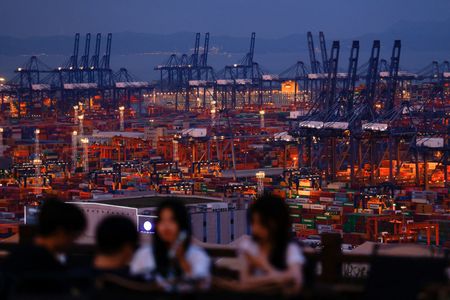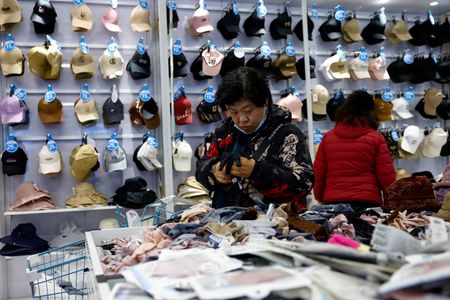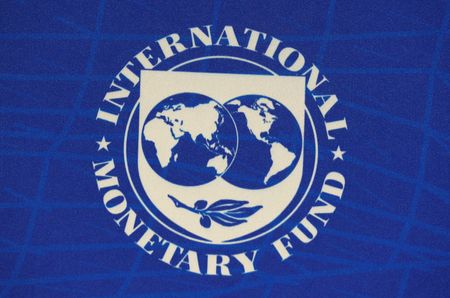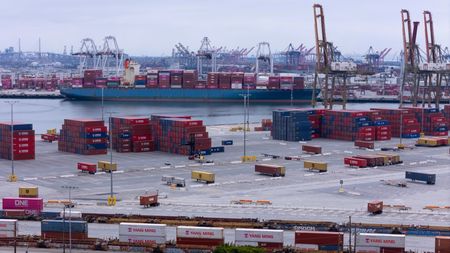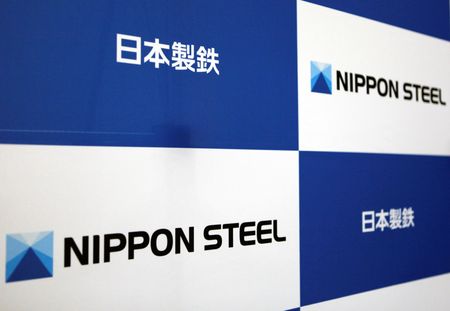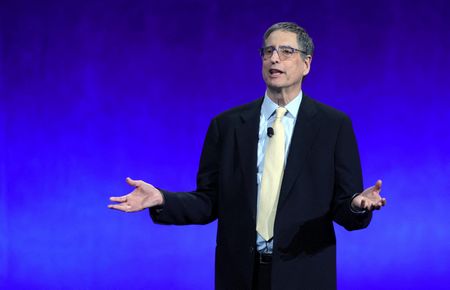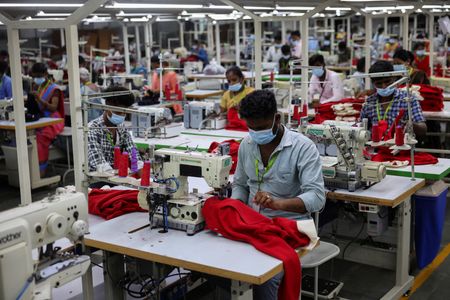By Laurie Chen and David Lawder
BEIJING/WASHINGTON (Reuters) -China and the United States start their first major Trade War Two meeting on Saturday to pull back from what analysts describe as a lose-lose situation for their economies, without much clarity on what a win would look like for either side.
China is at the epicentre of U.S. President Donald Trump’s global trade war that has roiled financial markets, upended supply chains and fuelled risks of a sharp worldwide economic downturn.
Washington wants to reduce its trade deficit with Beijing and convince China to renounce what the U.S. says is a mercantilist economic model and contribute more to global consumption, which would imply, among other things, painful domestic reforms.
Beijing resists any outside interference with its development path as it sees industrial and technological advancement as crucial to avoid the middle income trap. It wants Washington to remove tariffs, specify what it wants China to buy more of, and be treated as equals on the global stage.
The two sides seem much further apart and at greater risk of a major fallout than during their first trade war in Trump’s previous term.
And as U.S. Treasury Secretary Scott Bessent and chief trade negotiator Jamieson Greer meet China’s economic tsar He Lifeng in Switzerland, none of these outcomes look realistic, analysts say.
The triple-digit, two-way tariffs are not the only point of tension in the weekend talks. Non-trade issues such as fentanyl, tech restrictions and geopolitics including the war in Ukraine are likely to further complicate the path to any resolution to a trade conflict that is disrupting the global economy.
Indeed, in an indication of how deeply non-tariff issues are in the mix, China is sending a top public-security official to the talks, a source familiar with the plans said.
“They’re not going to resolve anything this weekend, other than just trying to determine if there’s going to be a process, and what the agenda items will be,” said Scott Kennedy, an expert in Chinese business affairs at the Center for Strategic and International Studies in Washington.
The best-case scenario for financial markets at this early stage would be an agreement to bring down tariffs from an excess of 100% – widely seen by markets as a virtual trade embargo – to levels that would allow products to flow each way, but still be hefty on American and Chinese businesses.
Trump, who unveiled the details of a new trade agreement between the United States and Britain, has signaled that punitive U.S. tariffs of 145% on Beijing would likely come down, and on Friday floated an alternative figure for the first time, saying on his social media platform that 80% “seems right.” Even that is 20 points above the level he pledged on the campaign trail last year to levy against Chinese goods, and it was unclear how it would be received by the team from China, if it is presented by his negotiating team at all over the weekend.
“I expect Beijing will insist on receiving the same 90-day waiver on tariffs that all other countries received to create conducive conditions for negotiations,” said Ryan Hass, director of the John L. Thornton China Center at the Brookings Institution, adding that breakthroughs are unlikely.
“Since the U.S. decisions to escalate tariffs were made arbitrarily, the decision to de-escalate tariffs can similarly be made arbitrarily.”
Most analysts don’t expect a waiver. But a tariff reduction, however small, and an agreement for follow-up talks that could eventually encompass non-trade issues like fentanyl would still be seen as a positive outcome by investors.
“If there is a temporary truce or symmetrical rollback of tariffs, that would be conducive to future potential holistic negotiation efforts,” said Bo Zhengyuan, Shanghai-based partner at consultancy firm Plenum.
TEMPORARY DE-ESCALATION
While either side might be able to dress any rollbacks as an early win to their domestic audiences, Chinese factories and their workers are likely to start feeling the tariff pain in coming months, while Americans are staring at higher prices and unemployment.
And the root cause of the conflict will still be there.
The lopsided global trade environment in which most economies around the world rely too heavily on affordable and efficient Chinese production on the supply side and wealthy American consumers for demand won’t be fixed by next week.
But markets for now are at least relieved that the world’s leading powers have a chance to walk back from a path of escalating threats that investors feared might spill over from trade into finance and other areas.
Lynn Song, ING’s chief Greater China economist, expects any de-escalation to bring back tariffs to around 60%, in line with Trump’s pre-election pledges.
This would “still be high enough to bar many products with suitable alternatives,” but also “a level that allows importers to buy products without substitutions with less pain,” she said.
RHETORICAL POSTURING
Before the Saturday meeting, much of the back-channel preparations between China and the United States were bogged down by disputes over fentanyl, the seniority of negotiating officials, and the tone of rhetoric used by the U.S., Reuters reported on Friday.
Conflicting statements from both sides over who approached whom led to a further hardening in Beijing’s public messaging, as one state newspaper warned of a “protracted struggle”.
However, China last week signalled through a state media-affiliated blog that engaging in talks “does no harm at this stage” and that Beijing can “use this opportunity to observe, and even draw out the U.S.’s true intentions”.
Analysts say that Beijing’s attempts to portray Washington as the more anxious and pressured party give it political cover to engage in talks, as well as projecting strength domestically.
“We are not watching anymore for who blinks first, but for how either side will spin the other as having blinked first,” said a Beijing-based diplomat.
(Additional reporting by Michael Martina and Andrea Shalal in Washington and the Hong Kong newsroomEditing by Shri Navaratnam)

